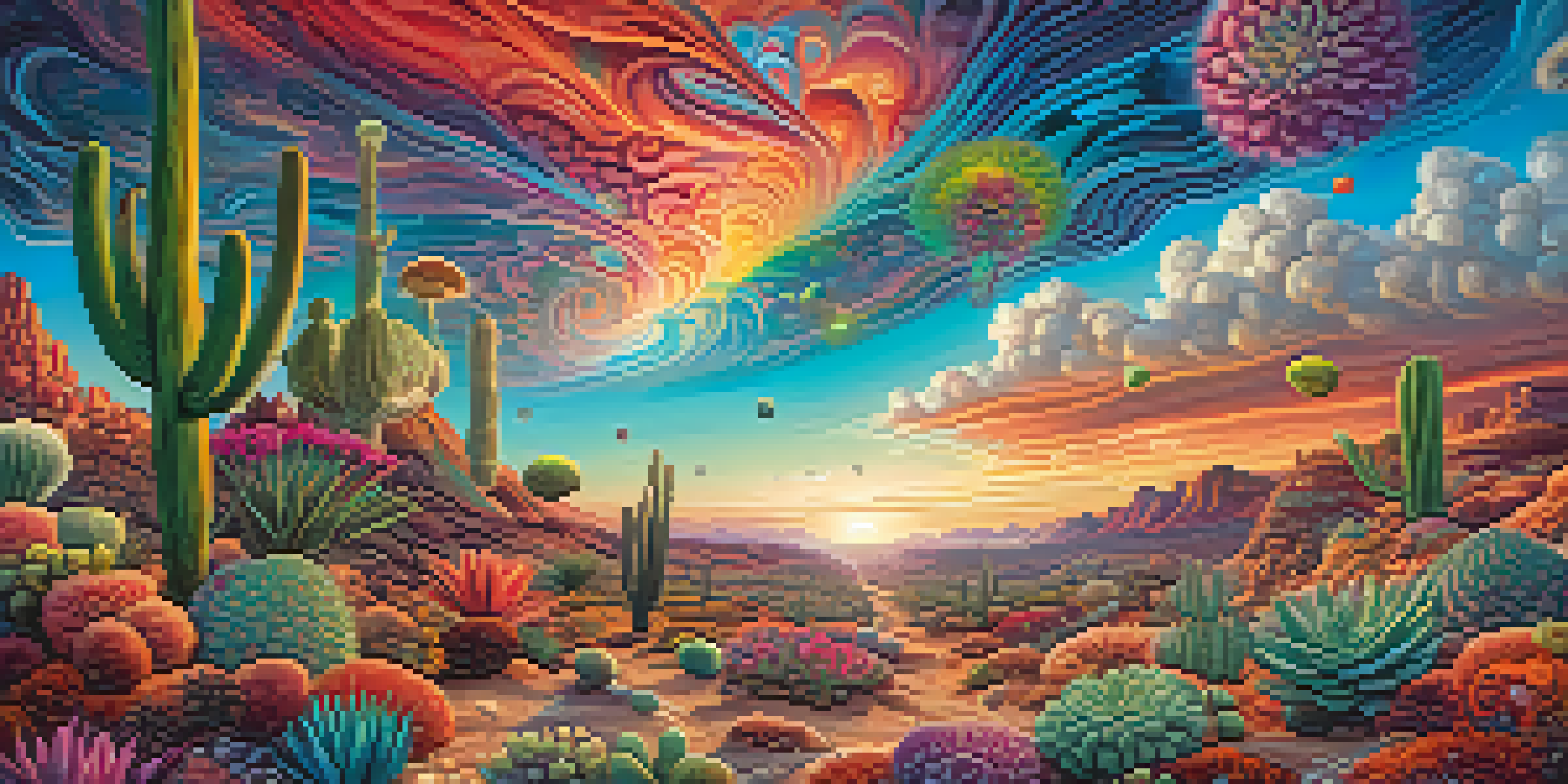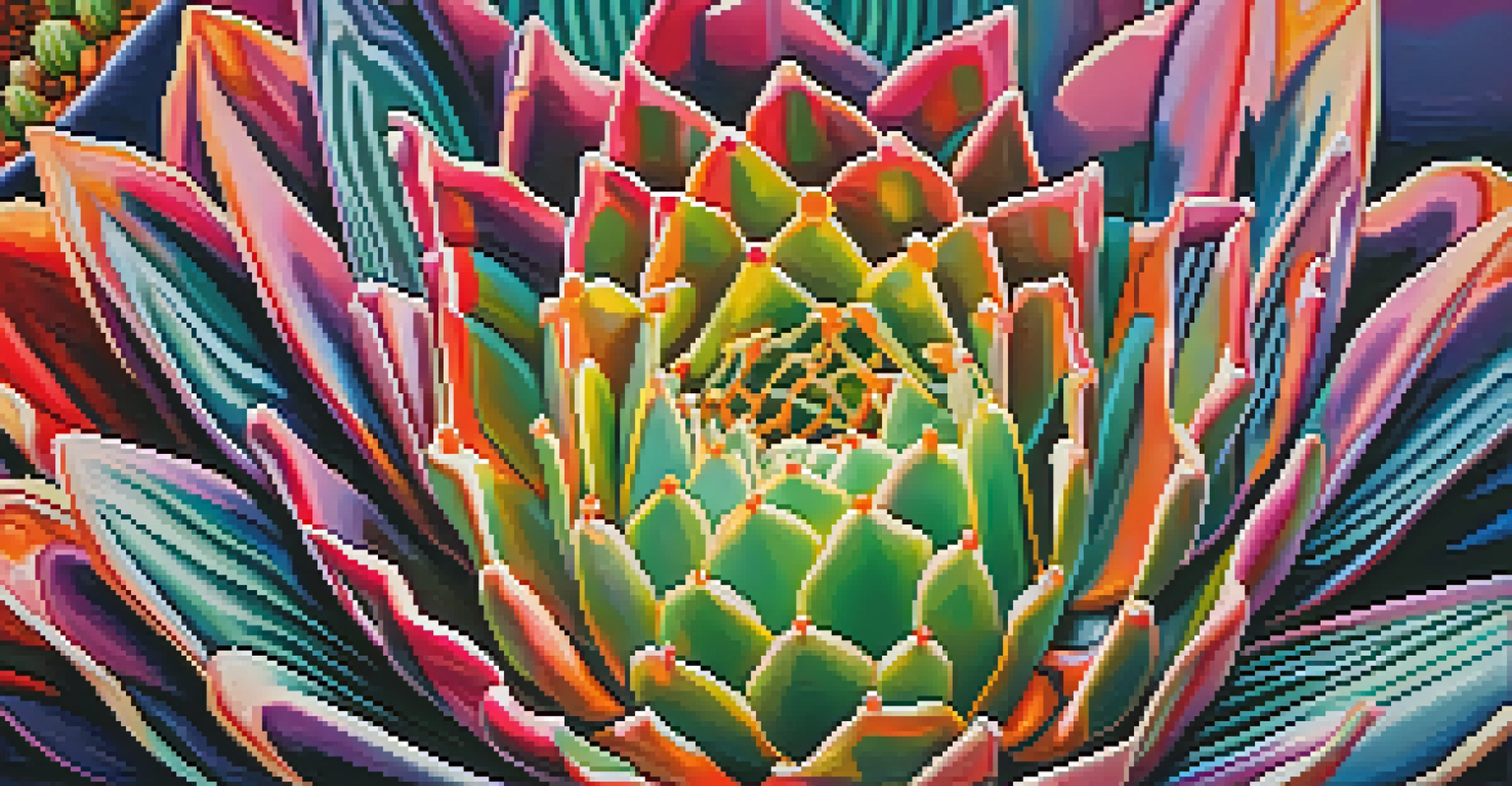Psychedelic Art: How Peyote Influences Visual Artists Today

The Roots of Psychedelic Art and Peyote's Role
Psychedelic art emerged in the 1960s, reflecting a cultural revolution that embraced altered states of consciousness. At the heart of this movement was peyote, a cactus containing mescaline, which has been used in Native American spiritual practices for centuries. Artists began to explore the vivid colors and intricate patterns that mirrored their psychedelic experiences, often drawing inspiration from their journeys with peyote.
Art is the most beautiful of all lies; it can take you to the depths of your consciousness and allow you to explore the uncharted territories of your mind.
As artists experimented with peyote, they discovered a way to visually communicate their inner landscapes. The swirling colors and surreal shapes often depicted in their artworks serve as a window into the mind's eye, capturing the essence of their experiences. This approach resonated with a generation seeking new forms of expression, leading to the distinct visual language we associate with psychedelic art today.
The influence of peyote extends beyond just the visual; it also invites a sense of connection and spirituality. Many artists report that their experiences with peyote have deepened their understanding of art as a means of exploring consciousness. This melding of art and spirituality continues to inspire contemporary artists, pushing boundaries and inviting new interpretations.
How Peyote Influences Contemporary Visual Artists
Today, many visual artists draw from the psychedelic aesthetic that peyote helped popularize. Artists like Alex Grey and Amanda Sage create works that fuse detailed imagery and vibrant colors to evoke spiritual and metaphysical concepts. Their art often reflects their experiences with psychedelics, including peyote, and serves as a way to share those profound insights with the world.

The resurgence of interest in psychedelics, both in art and in broader society, has led to a renewed exploration of themes related to perception and reality. This has opened doors for artists to experiment with new techniques and materials that reflect their psychedelic journeys. In this way, peyote continues to inspire innovation and creativity in the visual arts.
Psychedelic Art's Healing Power
Artists use peyote experiences to confront personal traumas, turning their art into a medium for healing and self-discovery.
Moreover, the community surrounding psychedelic art has grown, with festivals and exhibitions dedicated to this unique genre. These gatherings foster collaboration and dialogue among artists who share a common appreciation for the transformative power of psychedelics, including peyote. As artists connect and share their experiences, the impact of peyote on their work becomes even more pronounced.
The Visual Language of Peyote and Psychedelia
Psychedelic art is characterized by its visual language: vibrant colors, intricate patterns, and surreal imagery. Artists often use these elements to create a sense of depth and complexity, mirroring the layered experiences induced by peyote. This visual language not only captivates viewers but also invites them to explore their perceptions and emotions.
The creative process is a process of surrender, not control.
Patterns found in nature, such as spirals and fractals, are commonly incorporated into psychedelic art. These patterns resonate with the experiences of those who have journeyed with peyote, as they often report seeing similar shapes during their experiences. By integrating these elements, artists create a bridge between the viewer's reality and the transcendent experiences associated with peyote.
Additionally, light plays a crucial role in this visual language, as artists often experiment with luminosity and contrast to evoke a sense of movement and transformation. This dynamic quality of psychedelic art reflects the fluidity of consciousness experienced by those under the influence of peyote. Ultimately, the visual language serves as a powerful tool for artists to convey their unique perspectives.
Psychedelic Art as a Means of Healing
For many artists, the journey with peyote transcends mere inspiration; it becomes a tool for healing and self-discovery. The introspective nature of peyote experiences often leads artists to confront personal traumas and explore themes of mental health. Through their art, they can process these experiences, offering viewers a glimpse into their healing journeys.
Art has long been recognized as a therapeutic medium, and the psychedelic art movement is no exception. By channeling their emotional landscapes into their work, artists not only find solace but also create connections with others who may have similar experiences. This shared understanding fosters a sense of community and support, enhancing the healing power of art.
Cultural Significance of Peyote
Psychedelic art honors the cultural roots of peyote, fostering dialogue and appreciation for Indigenous traditions.
Moreover, galleries and exhibitions featuring psychedelic art often promote discussions around mental health and wellness. By showcasing these works, artists invite dialogue about the benefits of psychedelics, including peyote, in therapeutic settings. This growing recognition of art as a healing tool underscores the profound impact of peyote on the creative process.
Cultural Significance of Peyote in Art
Peyote holds deep cultural significance for many Indigenous communities, often used in religious ceremonies and rituals. As artists incorporate peyote's symbolism into their work, they contribute to a broader understanding of its role in these cultures. This fusion of contemporary art with traditional practices helps preserve and honor the heritage associated with peyote.
By acknowledging the cultural roots of peyote, artists can create works that are not only visually stunning but also rich in meaning. This respect for the source material allows for a dialogue between different cultures, fostering greater appreciation for the traditions surrounding peyote use. As such, psychedelic art evolves into a platform for cultural exchange and education.
Additionally, as the public becomes more aware of the historical and spiritual significance of peyote, contemporary artists can play a role in advocating for its responsible use. This advocacy helps ensure that peyote is respected and appreciated within both artistic and cultural contexts. Ultimately, this connection enriches the narrative surrounding psychedelic art.
The Future of Psychedelic Art and Peyote
As the fascination with psychedelics continues to grow, the future of psychedelic art appears vibrant and promising. Artists are increasingly experimenting with new mediums, such as digital art and virtual reality, to explore the themes associated with peyote. This evolution allows for even more immersive experiences that can transport viewers into the depths of their imagination.
Furthermore, the ongoing research into psychedelics and their therapeutic potential may inspire a new generation of artists. With the increasing acceptance of psychedelics in society, artists might feel more empowered to share their experiences and insights. This shift could lead to an even richer tapestry of psychedelic art that resonates with diverse audiences.
Future of Psychedelic Art
The evolving landscape of psychedelic art reflects a growing acceptance of psychedelics, inviting new artistic explorations and collaborations.
In this landscape, the dialogue between art and psychedelics will likely deepen, inviting collaboration across various disciplines. As artists, scientists, and spiritual practitioners unite, the impact of peyote on visual culture may evolve in unexpected and exciting ways. The future of psychedelic art is not just a reflection of individual experiences but a collective exploration of consciousness.
Conclusion: Embracing the Influence of Peyote in Art
Psychedelic art, deeply intertwined with the use of peyote, serves as a powerful medium for self-expression and cultural exploration. As artists draw from their experiences with peyote, they create works that resonate with themes of healing, spirituality, and connection. This art form enriches our understanding of consciousness and invites viewers to embark on their own journeys of discovery.
The influence of peyote on visual artists today continues to inspire innovation and creativity, as new generations explore the depths of their imagination. By embracing the cultural significance and healing potential of peyote, artists can create meaningful connections with their audiences. This dynamic interplay between art and psychedelics reveals the profound impact of peyote on the creative process.

As we look to the future, the relationship between peyote and art will likely evolve, reflecting broader societal changes and new understandings of consciousness. By celebrating and respecting this influence, we can foster a deeper appreciation for the vibrant world of psychedelic art and the experiences that shape it.